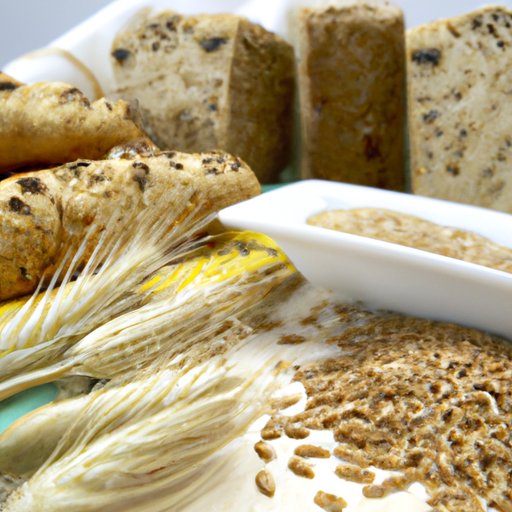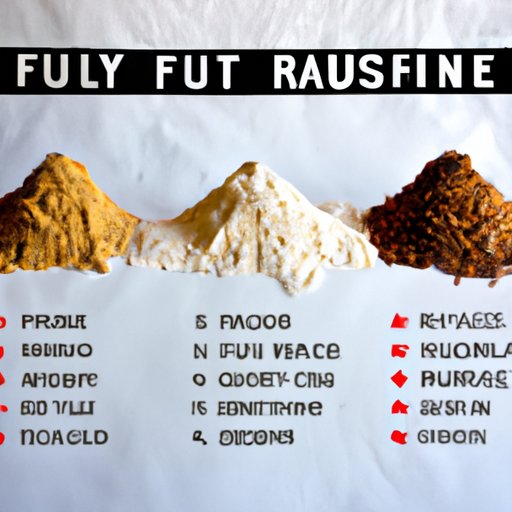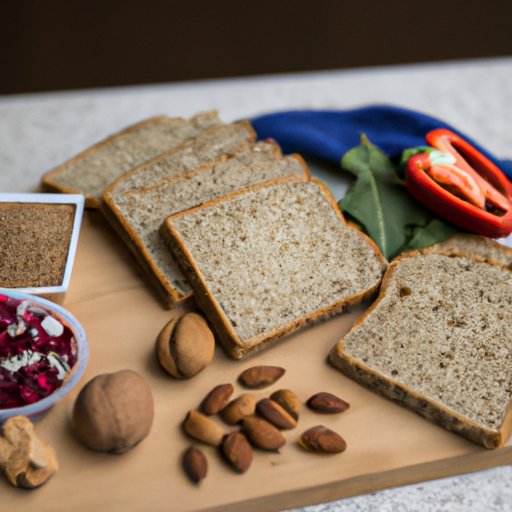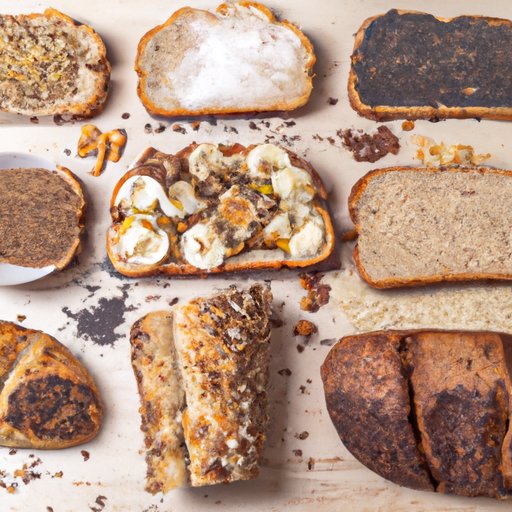Introduction
When it comes to making bread, many of us immediately think of unhealthy store-bought options. However, there are plenty of ways to make bread that is both delicious and healthy. So what do we mean when we talk about “healthy bread”? Generally speaking, healthy bread is made with wholesome ingredients including whole grain flours, nutritious fats, and natural sweeteners. In this article, we’ll explore the various methods for making healthy bread as well as tips for substituting healthier ingredients into your favorite recipes.
Step-by-Step Guide to Making Healthy Bread from Scratch
Making bread from scratch is a fun and rewarding process. Here’s a step-by-step guide to help you get started:
Gathering Ingredients
The first step in making bread from scratch is to gather all the necessary ingredients. This includes flour, yeast, salt, sugar, fat, and any other ingredients you may want to add for flavor or texture. Be sure to use only high-quality ingredients for the best results.
Mixing and Kneading the Dough
Once you have all the ingredients gathered, it’s time to start mixing and kneading the dough. Kneading helps to develop the gluten in the flour, which gives the bread its structure. You can knead the dough by hand or use a stand mixer with a dough hook attachment.
Shaping the Dough
Once the dough is ready, it’s time to shape it into the desired form. Depending on the type of bread you’re making, you may need to roll out the dough, form it into a loaf, or shape it into rolls. If you’re making a loaf of bread, you may want to score the top of the dough before baking.
Rising the Dough
After shaping the dough, it’s time to let it rise. This allows the yeast to do its job and produce carbon dioxide, which causes the dough to rise. The rising time will depend on the type of bread you’re making, as well as the temperature and humidity of your kitchen.
Baking the Bread
Once the dough has risen, it’s time to bake the bread. Preheat the oven to the desired temperature and place the bread in the oven. Depending on the type of bread you’re making, the baking time will vary. For most loaves of bread, the baking time is between 30 minutes and an hour.
Cooling and Storing the Bread
Once the bread is done baking, let it cool completely before slicing. This will ensure that the bread holds its shape and won’t crumble when you slice it. Store the bread in an airtight container or wrap it in plastic wrap to preserve freshness.
Tips for Substituting Healthier Ingredients in Your Favorite Bread Recipes
If you have a favorite bread recipe that isn’t necessarily healthy, there are some simple swaps you can make to turn it into a healthier version. Here are some tips to get you started:
Switching Out Refined Flours for Whole Grain Flours
Refined flours are stripped of their natural nutrients during processing, so they’re not the healthiest option for baking. Instead, opt for whole grain flours such as whole wheat flour, spelt flour, and oat flour. These flours are packed with vitamins and minerals and provide more fiber than refined flours.
Replacing Unhealthy Fats with Healthier Alternatives
Many bread recipes call for unhealthy fats like butter and lard. To make your bread healthier, try substituting these fats with healthier alternatives such as olive oil, coconut oil, or avocado oil. These oils are rich in beneficial fatty acids and can be used as a healthier alternative.
Adding Nutrient-Rich Superfoods to Your Recipes
Superfoods are nutrient-dense foods that are packed with vitamins, minerals, and antioxidants. Try adding some of your favorite superfoods to your bread recipes to boost the nutritional value. Popular superfoods include flaxseed, chia seeds, hemp seeds, walnuts, and dried fruits.

The Benefits of Baking with Whole Grains
Whole grains are a great addition to any diet. Not only do they provide essential vitamins and minerals, but they also offer a variety of health benefits. Some of the benefits of baking with whole grains include:
Improved Digestion
Whole grains are a good source of dietary fiber, which helps to keep the digestive system working properly. Studies have shown that consuming whole grains can reduce the risk of constipation and other digestive issues.
Lower Cholesterol Levels
Studies have found that eating whole grains can help to lower cholesterol levels. This is due to the fact that whole grains contain plant sterols, which are compounds that help to reduce cholesterol levels in the body.
Increased Intake of Vitamins and Minerals
Whole grains are an excellent source of vitamins and minerals. They are particularly rich in B vitamins, magnesium, zinc, and iron. Eating whole grains can help to increase your intake of these important nutrients.

How to Choose the Healthiest Flour for Your Baked Goods
When it comes to choosing the right flour for your baked goods, there are a few things to consider. Here are some tips to help you choose the healthiest flour for your recipes:
Understanding the Different Types of Flours
There are many different types of flours available, each with its own unique characteristics. For example, all-purpose flour is suitable for most baking needs, while bread flour is better suited for making yeast-risen breads. It’s important to understand the different types of flours and how they will affect the outcome of your baked goods.
Selecting the Right Flour for the Recipe
It’s important to select the right flour for the recipe. For example, if you’re making a cake, you’ll want to use a finer, lighter flour such as cake flour or pastry flour. On the other hand, if you’re making a loaf of bread, you’ll want to use a coarser, heavier flour such as bread flour.
Taking Into Consideration the Gluten Content
The gluten content of the flour you use can affect the texture of your baked goods. For example, flour with a higher gluten content will produce a chewier texture, while flour with a lower gluten content will produce a softer texture. For this reason, it’s important to take into consideration the gluten content of the flour when selecting it for a recipe.

Creative Ideas for Adding Nutrients to Your Bread
If you’re looking for new and creative ways to add nutrients to your bread, here are some ideas to get you started:
Incorporating Nuts and Seeds
Nuts and seeds are a great way to add extra nutrition to your bread. Try adding walnuts, almonds, pumpkin seeds, sunflower seeds, or sesame seeds to your batter for an added boost of protein and healthy fats.
Adding Dried Fruits
Dried fruits are a great way to add natural sweetness and extra nutrients to your bread. Popular options include raisins, cranberries, cherries, apricots, and dates.
Including Vegetables
Vegetables are another great way to add nutrients to your bread. Try adding grated carrots, zucchini, or sweet potatoes to your batter for a boost of vitamins and minerals.
The Healthier Side of Yeast-Risen Breads
Yeast-risen breads are a popular choice for many home bakers. To make them healthier, here are some tips to keep in mind:
Making Better Choices When Selecting Yeast
When selecting yeast for your bread recipes, opt for active dry yeast rather than rapid-rise yeast. Active dry yeast is made from natural sources and is free from preservatives and additives.
Reducing Sugar Content
Most yeast-risen bread recipes call for sugar, but you can reduce the amount to make the bread healthier. Try substituting half of the sugar with honey or maple syrup for a natural sweetener.
Utilizing Natural Sweeteners
In addition to reducing the amount of sugar in your recipes, you can also try using natural sweeteners such as honey, maple syrup, or molasses. These sweeteners are less processed and contain more nutrients than white sugar.
Conclusion
Making healthy bread is easier than you think! By using wholesome ingredients such as whole grain flours, nutritious fats, and natural sweeteners, you can create delicious, nutritious breads that are perfect for any occasion. Don’t be afraid to experiment and try out different ingredients and techniques to find the perfect combination for your taste. If you’re looking for more information on healthy baking, there are plenty of resources available online.
(Note: Is this article not meeting your expectations? Do you have knowledge or insights to share? Unlock new opportunities and expand your reach by joining our authors team. Click Registration to join us and share your expertise with our readers.)
